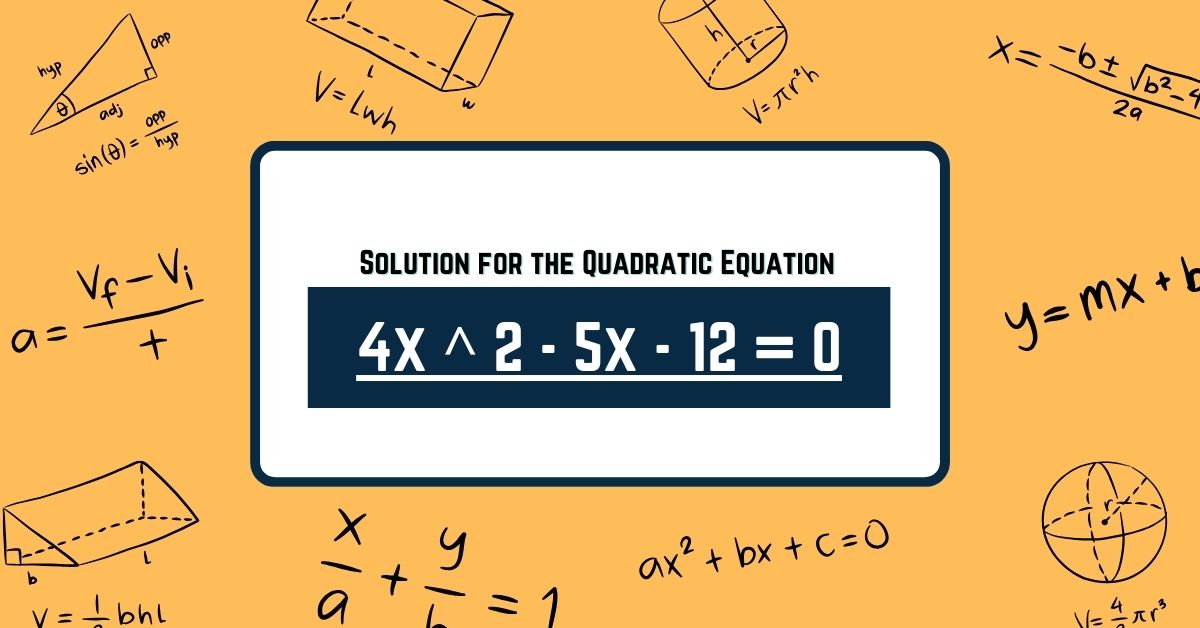Fundamental To Algebra, Quadratic Equations Are Widely Used In Many Branches Of Science And Engineering. The Quadratic Equation 4×2−5x−12=04x^2 – 5x – 12 = 04×2−5x−12=0 Will Be Solved In This Tutorial. Procedure By Step, And Investigate The Techniques Employed To Solve It.
Understanding The Quadratic Equation:
The Formula For A Quadratic Equation Is Ax2 + Bx + C = 0ax^2 + Bx + C = 0ax2 + Bx + C = 0. Where The Constants Aaa, Bbb, And Ccc Are. In Our Formula: 04x^2 – 5x – 12 = 04×2 – 5x – 12 = 4×2 – 5x – 12 = 0 We Possess:
• A=4a = 4a=4
• B=-5b = -5b = −5
• C=-12c = -12c = -12
Techniques For Resolving The Quadratic Formula:
There Exist Multiple Techniques For Resolving Quadratic Equations, Such As:
1. Calculating
2. Making Use Of The Quadratic Formula
3. Finishing Up The Square
4. The Graphical Approach
The Most Common Technique Will Be Applied Here, Which Is The Quadratic Formula.
Using The Formula For Quadratics:
According To The Quadratic Formula, The Answers To The Problem Ax2+Bx+C=0ax^2 + Bx + C = 0ax2+Bx+C=0 Are Are As Follows: X=−B±B2−4ac2ax = \Frac{-B \Pm \Sqrt{B^2 – 4ac}}{2a}X=2a−B±B2−4ac
Using This Formula, Let’s Solve Our Equation.
Comprehensive Solution
Determine The Coefficients:
A = 4, B = -5, C = -12; A = 4, B = -5, \Quad C = -12; A = 4, B = -5, C = -12;
Find The Discriminant:
Δ=B2−4acdelta Is Equal To B^2 – 4ac.Δ=B2−4ac Δ=(−5)2−4(4)(−12)\Delta Is Equal To (-5)^2- 4(4)(-12)Δ=(−5)2−4(4)(−12) Δ=25+192\Delta Is Equal To 25 Plus 192.Δ=25+192 Δ=217\Delta = 217Δ = 217
Utilize The Quadratic Formula To Calculate The Solutions:
X = -B \Pm \Sqrt{\Delta}}{2a}X=2a−B±Δ X=5±2178x = \Frac{5 \Pm \Sqrt{217}}{8}X Equals 85±217
Make The Solutions Simple:
O X1=5+2178x_1 = \Frac{5 + \Sqrt{217}}{8}X1=85+217 Is The Positive Root.
O X2=5−2178x_2 = \Frac{5 – \Sqrt{217}}{8}X2=85−217 Is The Negative Root.
The Quadratic Equation 4×2−5x−12=04x^2 – 5x – 12 = 04×2−5x−12=0 May Thus Be Solved As Follows: X1=5+2178,X2=5−2178x_1 = \Frac{5 + \Sqrt{217}}{8}, \Quad X_2 = \Frac{5 – \Sqrt{217}}{8}X1=85+217,X2=85−217
Checking The Solutions:
Verifying The Solutions By Re-Entering Them Into The Original Equation Is Generally A Good Idea.
1. Replace X1x_1x1 With 4(5+2178).\Left( \Frac{5 + \Sqrt{217}}{8} \Right) = 2−5(5+2178)−12^2 – 5 (\Frac{5 + \Sqrt{217}}{8} \Right) – 12 = 04(85+217)2−5(85+217)-12=0 This Expression’s Simplification Should Result In 0, Indicating That X1x_1x1 Is A Legitimate Answer.
Replace X2x_2x2 With 4(5−2178)\Left(\Frac{5 – \Sqrt{217}}{8} \Right) = 2−5(5−2178)−12=04.^2 – 5 (\Frac{5 – \Sqrt{217}}{8} \Right) 12 – 2(85- 217) = 0; + 5(85- 217) = -2 Likewise, If This Expression Is Simplified, The Result Should Be 0, Indicating That X2x_2x2 Is A Legitimate Answer.
Visual Representation:
The Locations On A Graph Where The Parabola Y=4×2−5x−12y = 4x^2 – 5x – 12y=4×2−5x−12 Crosses The X-Axis Are The Quadratic Equation’s Solutions. The Two Roots Discovered Using The Quadratic Formula Would Be Visually Confirmed By Plotting This Function.
Summary:
The Quadratic Equation 4×2−5x−12=04x^2 – 5x – 12 = 04×2−5x−12=0 Can Be Solved. Using The Quadratic Formula Yields The Following Answers: X_1 = \Frac{5 + \Sqrt{217}}{8}, \Quad X_2 = \Frac{5 – \Sqrt{217}}{8}, X1 = 5+2178, X2 = 5−2178×1 = 85 + 217, X2 = 85 – 217
This Approach Is Dependable And Yields Precise Solutions For Any Quadratic Equation. Never Forget To Double-Check Your Answers, And If At All Feasible, Present Them Graphically To Aid With Comprehension.

